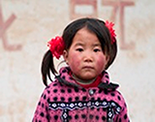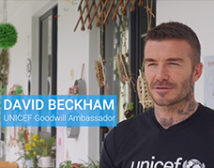The monk has auspicious patterns tattooed on his forearms. He believes they will chase away evil spirits and protect him from contracting incurable diseases.
That belief is being put to the test in the wake of the HIV/AIDS threat looming over this subtropical part of south-west China and reaching right to the doors of the 1,400-year-old Manchunman Temple where Du Su, 24, was ordained 14 years go.
“Being a monk doesn't necessarily immunize you from HIV. Really, nothing can keep that evil away unless you live a healthy life: no drug abuse, no unsafe sex,” says the young monk shyly, glancing at his tattooed right wrist.
He became aware of the dreadful disease when it killed his master's younger brother, who was believed to have contracted it through promiscuous behaviour in Myanmar. Such events such have incited most of the 6,000 Buddhist monks in 563 temples of China's Xishuangbanna Dai Autonomous Prefecture in Yunnan Province to work together against the spread of HIV/AIDS. UNICEF is supplying them with the tools they need to be successful.
The results of a UNICEF-funded training programme are achieving ever-wider impact throughout Xishuangbanna. Thanks to the in-depth instruction provided by the programme, monks are educating youngsters and older people, changing behaviours, preventing new HIV infections and ultimately saving lives.
Yunnan's HIV prevalence rate is estimated at 0.17 per cent, compared to 0.1 per cent for China as a whole. The province borders the poppy-producing Golden Triangle, and HIV is transmitted mainly through intravenous drug use. Unprotected sex accounts for about 11 percent of all AIDS cases. Throughout Yunnan, 11,567 HIV/AIDS cases have been reported and 477 deaths since 1989. But health authorities say actual HIV/AIDS infections could be seven times as high, around 70,000.
Started in 1997, the UNICEF Yunnan Mekong Sub-region HIV/AIDS Prevention and Care Project has trained 562 monks from Xishuangbanna in HIV/AIDS awareness and counselling skills, says Yang Wenyao, a local AIDS control officer who has being involved in the project for six years. UNICEF spent US $41,000 training monks as of year-end, 2002, while the estimated budget for Buddhist monk initiatives in 2003 is US $50,000. <updated figures available?>
More than one third of Xishuangbanna's population—300,000 people—are Buddhists. Given their prevalence, says Yang, “We're hoping to use the monks' impact on the community to educate people, both the secular and the sacred. An effective way is to combine Buddhist doctrines with scientific information.”
Du Bing, a 20-year-old monk, says the first person he actually talked to directly about AIDS prevention was his mother. After a divorce, she had formed a new family. “I told her to be aware of unsafe sex and never to touch drugs,” he says. “She didn't know anything about this incurable disease before.”
Since taking a religious vow of chastity at age 10, Du Bing thought he was well insulated from the kinds of risky behaviours that can cause HIV infection. But from the UNICEF training programme, he learned that even innocent activities such as head shaving and being tattooed could be dangerous if the blade or needle is not clean.
With UNICEF's help, Buddhist monks are producing their own HIV/AIDS education materials in the Dai minority language and using sermons and spiritual counselling to teach men, women, and young people about the disease. The monks are also getting the message across with illustrated lectures and videotapes, and by singing songs adapted from Buddhist scriptures and composed by the monks themselves.
“The monks have a far greater impact on local communities than we do,” admits Yang Hongwen, an official of the local Communist Youth League. Several years ago, she recalls, when she and 120 volunteers launched a campaign against HIV/AIDS in rural communities, “Very few people would take the leaflets that illustrated three methods of HIV transmission.” To her amazement, however, more than 200 leaflets were instantly distributed when the monks began speaking Dai dialect, she says.
The monks regard it as their obligation to fight the AIDS scourge. “The Buddha has set us an example by delivering people from suffering and relieving society from disasters,” says Ma Hazhuang of the Central Temple. “Now that our society is threatened by the AIDS epidemic, we as followers of Buddha cannot stand idle. Without a healthy society, our temple, and even Buddhism itself, cannot survive. ”
Aside from campaigns focused on prevention and fighting discrimination against those living with the disease, the Central Temple is planning to initiate care and support programmes for AIDS patients and orphans with financial and technical support from UNICEF and other international agencies.
UNICEF got the ball rolling in the monks' battle against AIDS. Although it would be naïve to think Buddhist monks alone can defeat the disease, “They are a positive force in the war against it,” says Wang Yunsheng. “Thanks to their participation, the momentum of the AIDS epidemic in ethnic rural villages along the borders of Xishuangbanna has been checked, although the situation in the province as a whole is still grave.”
By Wen Chihua, China Features




























